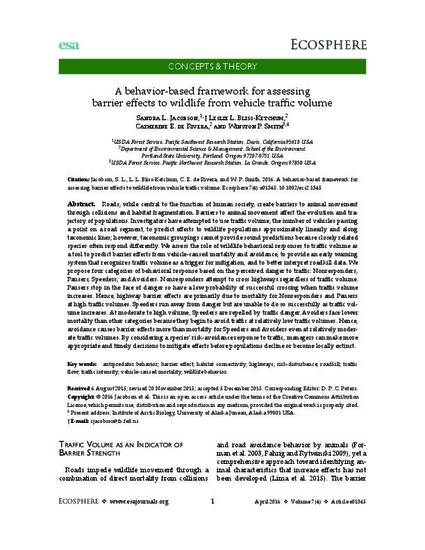
- Vehicle-animal collisions,
- Traffic safety and wildlife,
- Roadkill,
- Animal ecology,
- Wildlife habitat improvement
Roads, while central to the function of human society, create barriers to animal movement through collisions and habitat fragmentation. Barriers to animal movement affect the evolution and trajectory of populations. Investigators have attempted to use traffic volume, the number of vehicles passing a point on a road segment, to predict effects to wildlife populations approximately linearly and along taxonomic lines; however, taxonomic groupings cannot provide sound predictions because closely related species often respond differently. We assess the role of wildlife behavioral responses to traffic volume as a tool to predict barrier effects from vehicle-caused mortality and avoidance, to provide an early warning system that recognizes traffic volume as a trigger for mitigation, and to better interpret roadkill data. We propose four categories of behavioral response based on the perceived danger to traffic: Nonresponders, Pausers, Speeders, and Avoiders. Nonresponders attempt to cross highways regardless of traffic volume. Pausers stop in the face of danger so have a low probability of successful crossing when traffic volume increases. Hence, highway barrier effects are primarily due to mortality for Nonresponders and Pausers at high traffic volumes. Speeders run away from danger but are unable to do so successfully as traffic volume increases. At moderate to high volume, Speeders are repelled by traffic danger. Avoiders face lower mortality than other categories because they begin to avoid traffic at relatively low traffic volumes. Hence, avoidance causes barrier effects more than mortality for Speeders and Avoiders even at relatively moderate traffic volumes. By considering a species’ risk-avoidance response to traffic, managers can make more appropriate and timely decisions to mitigate effects before populations decline or become locally extinct.
Copyright: © 2016 Jacobson et al.
This work is licensed under a Creative Commons Attribution 4.0 International License.
